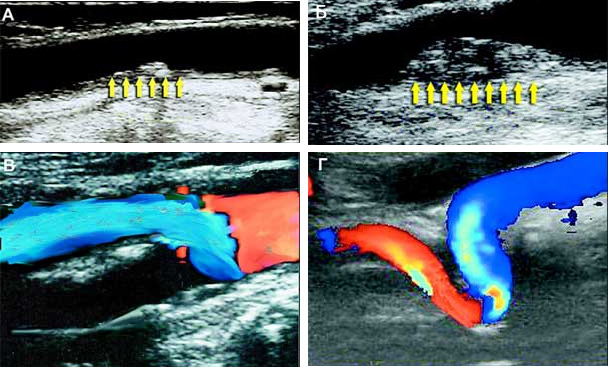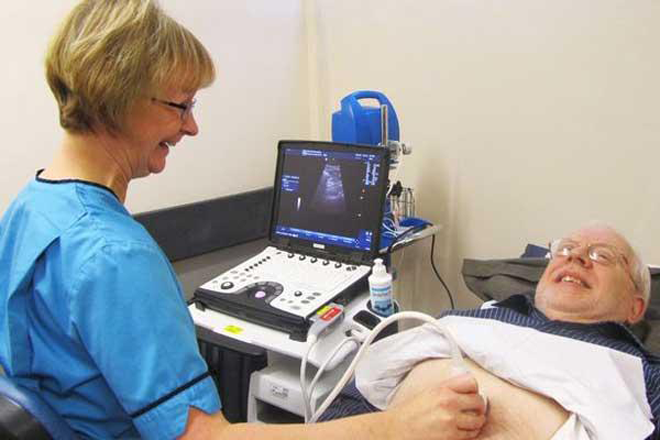The duplex diagnostic method involves the simultaneous study of the characteristics of the patency of the vessels (their tortuosity, narrowing, compression) and the degree of their filling with blood. When scanning the vascular bed of the head and neck, conventional ultrasound and Doppler ultrasound are combined. This method has greater diagnostic value than rheoencephalography.
Read in this article
Why is a duplex head and neck scan prescribed?
When studying the state of the vessels, the following changes can be identified:
- the degree of extensibility of the vascular wall;
- whether there is damage to the inner shell;
- the presence of blood clots or atherosclerotic plaques in the lumen of the vessel;
- the correctness of the anatomical shape and branches in the vascular bed.
The particular value of this method is the ability to assess the threat from the existing atherosclerotic plaque. If it is tightly connected to the vessel wall, the risk of blockage is negligible.
Duplex scanning of veins and vessels of the neck
Such a study can help diagnose signs of atherosclerosis of the cervical arteries, how pronounced their narrowing, the presence of signs of inflammation, diabetic angiopathy, messages between the venous and arterial networks, impaired blood outflow through the veins or entry into cerebral tissues due to osteochondrosis of the spine.
Duplex scanning of head arteries, brachiocephalic vessels, brain
With the help of scanning, you can examine the patency of the carotid artery, the brachiocephalic trunk (carotid and vertebral arteries), a branch of the left artery located under the collarbone. The blood supply to the brain depends on the patency of these vessels. Research can reveal:
- anatomical structural anomalies;
- traumatic injury;
- aneurysmal enlargement;
- inflammation or diabetic vascular disease;
- compression by a tumor, edema, hemorrhage;
- poor circulation due to spasm or blockage.

 Duplex scanning of the internal carotid artery: A - atherosclerotic plaque (shown by arrows); B - the lumen of the vessel is blocked by a large plaque (shown by arrows); B - complete closure of the vessel lumen with a plaque; D - convoluted artery.
Duplex scanning of the internal carotid artery: A - atherosclerotic plaque (shown by arrows); B - the lumen of the vessel is blocked by a large plaque (shown by arrows); B - complete closure of the vessel lumen with a plaque; D - convoluted artery. Benefits of duplex head and neck scans
The advantage of a duplex examination is to determine the degree of circulatory disturbance and its cause. This helps to assess the risk of acute vascular disorders, the time of their occurrence, and choose the right treatment tactics. The possibilities of this method are as follows:
- Can be diagnosed without complaints (at an early stage of the disease).
- Detection of blockage or narrowing of the vessel, localization and influence on the blood supply.
- Assessment of the risk of complete vessel occlusion.
- Study of spasm of the venous network and deviations of venous hemodynamics.
- Determination of compensation possibilities in the presence of an obstacle to blood flow.
- Evaluation of the treatment performed.
- Identification of indications for surgical intervention.
Indications for a scheduled duplex scan
A vascular scan will help determine the cause for such complaints:

This technique is indicated before performing operations on the heart, vessels of the neck, head, it will help reduce the risk of complications from manual therapy and massage of the collar zone.
For some categories of people, it makes sense to undergo a study even in the absence of clinical signs: after the age of 45, with a hereditary predilection for diabetes mellitus, hypertension or angina pectoris, smoking, after a stroke, after detecting high blood cholesterol levels, with obesity. Routine diagnostics are performed at least once a year.
Preparing for a duplex head and neck scan
On the day of the examination, it is necessary to exclude the intake of caffeine in pills or drinks, which means that you cannot drink coffee, energy drinks, black and green tea. Smoking and alcohol consumption are prohibited. If vascular drugs have been prescribed, then their use must be agreed with the doctor, as they distort the scan data. Before the procedure, you will need to remove all hairpins, and then wash your hair.
Duplex scanning of the head and neck
The duration of the study, as a rule, does not exceed 40 minutes. The probe for scanning is lubricated with a special gel for ultrasound, it is passed over the scalp and neck. The received signals are sprinkled through a computer system onto a screen, where they are visualized as a typical image. In addition, the device detects the movement of blood cells, a color picture of the direction and distribution of blood flow is obtained.
If necessary, exercise tests can be performed to determine the reserve ability to increase blood flow with increased demand.
For the benefits and conduct of a duplex head and neck scan, see this video:
Decryption of the received data
After the data on the state of the vessels has been obtained, the doctor may come to the following conclusions:

In addition, the size of the atherosclerotic plaque, its adhesion to the vessel, and the possibility of detachment from the wall are described.
Duplex scanning cost
Depending on the scope of the study and the need for functional stress tests, the cost of a head and neck scan can vary from 1200 to 3700 rubles. On average, prices are about 2,500 rubles. Only a study of the vessels of the neck or only the brachiocephalic vessels can be carried out. In such cases, the price can be significantly reduced.
Duplex scanning of blood vessels helps to visualize changes in their anatomical shape, narrowing, compression, as well as blockage by a thrombus, atherosclerotic plaque, and at the same time to study hemodynamic disturbances that occur with such a pathology. It is used both for early diagnosis and for assessing the risk of developing acute cerebrovascular accidents.
Read also
An ultrasound scan of the brachiocephalic arteries is performed according to the patient's complaints related to blood circulation in the brain, dizziness and others. Norms for ultrasound, as well as deviations in duplex scanning, will confirm or deny the diagnosis.




